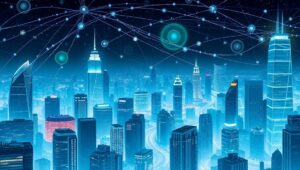The Societal Impact of a Hyper-Connected IoT World (2028)
The Internet of Things (IoT) has rapidly evolved from a futuristic concept to an integral part of our daily lives. As we approach 2028, the proliferation of interconnected devices promises a hyper-connected world, offering unprecedented convenience and efficiency. However, this pervasive connectivity also raises significant societal implications that warrant careful consideration.
Enhanced Automation and Efficiency
One of the most significant impacts of a hyper-connected IoT world is the enhanced automation across various sectors. Smart homes equipped with IoT devices can automate lighting, temperature control, and security systems, optimizing energy consumption and improving living standards. In industries, IoT-enabled sensors and machinery facilitate predictive maintenance, reducing downtime and increasing productivity. Smart cities leverage IoT to manage traffic flow, optimize waste collection, and enhance public safety, leading to more sustainable and livable urban environments.
Improved Healthcare
The healthcare sector stands to benefit immensely from a hyper-connected IoT ecosystem. Wearable devices and remote monitoring systems enable continuous tracking of vital signs, allowing for early detection of health issues and personalized treatment plans. IoT-enabled medical devices can automate drug delivery, monitor patient adherence, and provide real-time feedback to healthcare providers. Telemedicine, facilitated by IoT infrastructure, extends healthcare access to remote and underserved populations, improving overall healthcare outcomes.
Transforming Transportation
IoT is revolutionizing the transportation industry through connected and autonomous vehicles. Self-driving cars, equipped with sensors and communication capabilities, promise to reduce traffic congestion, improve road safety, and enhance mobility for individuals with disabilities. Smart infrastructure, such as connected traffic lights and parking systems, optimizes traffic flow and reduces commute times. IoT-enabled logistics and supply chain management enhance efficiency and transparency, enabling real-time tracking of goods and streamlined delivery processes.
Addressing Security and Privacy Concerns
While the benefits of a hyper-connected IoT world are substantial, it is crucial to address the associated security and privacy concerns. The proliferation of interconnected devices creates numerous potential entry points for cyberattacks, posing risks to personal data, critical infrastructure, and national security. Robust security measures, such as encryption, authentication, and intrusion detection systems, are essential to protect IoT devices and networks from malicious actors. Additionally, clear and comprehensive data privacy regulations are needed to ensure that personal data collected by IoT devices is used responsibly and ethically.
Ethical Considerations
Beyond security and privacy, the societal impact of a hyper-connected IoT world raises several ethical considerations. Algorithmic bias in AI-powered IoT systems can perpetuate and amplify existing societal inequalities, leading to unfair or discriminatory outcomes. The potential for job displacement due to automation necessitates proactive measures to retrain and reskill workers for the jobs of the future. Furthermore, the concentration of data and control in the hands of a few large corporations raises concerns about market dominance and the erosion of individual autonomy.
The Future of IoT
As we move closer to 2028, the societal impact of a hyper-connected IoT world will continue to evolve. By addressing the security, privacy, and ethical challenges proactively, we can harness the transformative potential of IoT to create a more sustainable, equitable, and prosperous future for all. It is essential for policymakers, industry leaders, and individuals to collaborate and establish clear guidelines and standards that prioritize human well-being and societal values in the design and deployment of IoT technologies.




